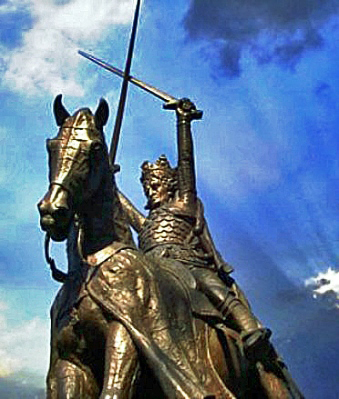| lithaz.org: home & art/culture events organizations publications |
| 5/15/2015 |
Lithuanian history:Jogaila
Jogaila, was born in Vilnius in 1351 to Grand Duke Algirdas of Lithuania and his second wife Uliana, daughter of Aleksander Mikhailovich, Prince of Tver. Jogaila was Uliana's first and most favored son. Jogaila, however, must have had qualities of character that distinguished him from his 4 brothers and 7 half-brothers in the eyes of his father Algirdas as well, for Algirdas chose Jogaila to rule in Vilnius as his successor and Grand Duke of Lithuania. Algirdas also convinced his own brother Kęstutis, the second most powerful ruler in Lithuania of Jogaila's worthiness to rule. Thus after Algirdas died in 1377, Jogaila became the Grand Duke of Lithuania with the full support of his uncle Kęstutis. It appeared that the years of close cooperation of the two brothers Algirdas and Kęstutis would continue with Jogaila and Kęstutis. But Kęstutis was 79 and Jogaila was 26 years old. They were men of two different generations and the experience gap between the two was enormous. It would have been vastly better if Kęstutis had stepped aside at this time and installed his very capable son Vytautas as his successor. Vytautas and Jogaila were close in age and experience and had grown up in each other's company, Jogaila in Vilnius and Vytautas in nearby Trakai. Joint rule by Jogaila and Kęstutis was clearly unsustainable. Lithuania's enemy The Teutonic Knights saw an opportunity here to divide and conquer. They offered peace to Jogaila and denied it to Kęstutis causing distrust and conflict between the two. Kęstutis, believing that Jogaila was plotting against him, marched on Vilnius in 1381 and took power himself. Warfare erupted between Kęstutis, Jogaila, and their supporters. In July of 1382 as two large armies met near Trakai, Jogaila invited Kęstutis and Vytautas to discuss a truce. When the negotiations failed, Jogaila detained Kęstutis and Vytautas by force, sent a message to Kęstutis forces to disperse, and took Kęstutis and Vytautas to Vilnius, where Vytautas was confined. Kęstutis was moved farther east to the castle in Krevo. A few days later, on August 10-11, Kęstutis was killed by servants sent from Vilnius, possibly on orders of Jogaila's protective mother Uliana. Vytautas, however, blamed his cousins Jogaila and Skirgaila for his father's death. Vytautas had managed to escape from Vilnius and continued his fight against Jogaila with the help of the Teutonic Knights. after the death of King Louis of Poland, his 9 year old daughter Jadwiga was crowned Queen of Poland in 1382 and a search for a suitable husband began. In 1386, Jogaila sent his representatives to Cracow to seek Jadwiga's hand in marriage. Agreement was reached on condition that Jogaila and Lithuania convert to Roman Catholicism. In March 1386, Jogaila was baptised, married Jadwiga, and was crowned as Ladislas II King of Poland. He continued to rule Lithuania. The Roman Catholic Church was endowed with Lihuanian lands and The process of Lithuanian conversion to Christianity began. Queen Jadwiga, the person most responsible for Lithuanian conversion, died in 1399, leaving Jogaila in sole control of the Polish crown. In 1392, Jogaila as King of Poland decided that Vytautas was more dangerous to him working with the Teutonic Knights than he would be ruling in Lithuania, and reconciled with Vytautas. He returned to Vytautas his family's lands and recognized him as the Grand Duke of Lithuania. Working jointly the two of them changed the military balance in the region. With Lithuania's conversion to Christianity its archenemy, the Order of Teutonic Knights, lost the legitimacy for its aggression against Lithuania, and now was faced with combined Lithuanian and Polish military forces. The showdown came on July 15, 1410 at Tannenberg in Prussia, where the Order and its allies were soundly defeated by a Lithuanian army with East Slav and Tatar allies led by Vytautas and a Polish army led by Jogaila.
In the spring of 1434, as was his custom, Jogaila went to a forest at night to listen to the songs of nightingales. During the night there was a sharp drop in temperature and Jogaila caught a fever. Despite the best efforts of his physicians, the fever got worse. Jogaila died on June 1 at the age of 83 and was buried in the Gniezno cathedral. On July 25 his older son was crowned as King Ladislas III of Poland. (Click here to read more history.) |
